Mythology and Symbology of Hindu Gods and Goddesses: Lord Subramanya, Lord Hanuman and Goddess Durga.
(NOTE: This is the second part of the article focusing on Lord Subramanya, Lord Hanuman and Goddess Durga. In the previous article, we discussed the need for understanding of the symbols and myths; and narrated the stories and symbols of Lord Ganesh. These lectures were given in January 2017 to Austin College, Sherman, Texas USA).
Define MYTH? One of the readers mentioned that the use of the word “myth” implies false stories and hence why we need to use Mythology in describing the stories of our beloved Gods and Goddesses. If we look at the definition of the word, it is defined in three-four different ways. One of the definitions found in Dictionary.com says, “a set of stories, traditions, or beliefs associated with a particular group or the history of an event, arising naturally or deliberately fostered.” Similarly, Collins English Dictionary defines myth as “a body of stories about a person, institution, etc.” Hence, we are using the word Myth to mean the prevalent stories and narrations as per our traditions and scriptures.
Lord Subramanya
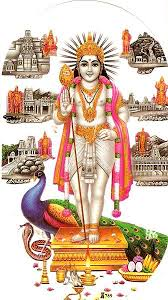 Shiva married Sati Devi, the daughter of Daksha who abhors Shiva because he was a Vishnu Bhakta. To insult Shiva, he organized a Maha Yajna and purposefully declined to extending invitation to Lord Shia. He invited all Gods except him. Uninvited, Sati went to Yajna only to be insulted by her father. Unable to bear the insult, she immolated herself. Realizing Sati’s death, Veerabhadra, the Avatara of Shiva, appeared at the yajna polluted the fire worship, broke all the vessels, insulted the priests, threw away all the puja items, cut off Daksh’s head, trampled on Yama, broke the staff of Yama, scattered the Gods all around and left to Kailash for meditation. Tarakasura did severe tapas and received a boon from Lord Shiva that nobody can kill him except Lord Shiva’s energy. Thus, Tarakasura, Surapadman and other Asuras took advantage of Shiva’s absence, and rampaged the earth and heaven.
Shiva married Sati Devi, the daughter of Daksha who abhors Shiva because he was a Vishnu Bhakta. To insult Shiva, he organized a Maha Yajna and purposefully declined to extending invitation to Lord Shia. He invited all Gods except him. Uninvited, Sati went to Yajna only to be insulted by her father. Unable to bear the insult, she immolated herself. Realizing Sati’s death, Veerabhadra, the Avatara of Shiva, appeared at the yajna polluted the fire worship, broke all the vessels, insulted the priests, threw away all the puja items, cut off Daksh’s head, trampled on Yama, broke the staff of Yama, scattered the Gods all around and left to Kailash for meditation. Tarakasura did severe tapas and received a boon from Lord Shiva that nobody can kill him except Lord Shiva’s energy. Thus, Tarakasura, Surapadman and other Asuras took advantage of Shiva’s absence, and rampaged the earth and heaven.
As per one of the legends, only Shiva’s son can kill these demons. Since he was in meditation, Kamadeva was given the responsibility of waking him up. Obliging to have a son who can kill Tarakasura, Shiva asked which one carry his vital energy when discharged. Agni agreed but unable to bear the power of energy and decided to release it into Ganges water. Unable to bear the burden of the energy, she deposited in a Saravana forest. Energy split and spread into six different places. Six Krithika ladies breast fed them and they developed into one body with six faces. Shiva and Parvati appear. Shiva declared that the child will be the son of Krithikas who will be known as Karthikeya. He will be called Kumar Swamy as she was the son of Ganga. He will be known as the son of Parvati under the name of Skanda; as the son of Shiva he will be known as Guha; as the son of Agni he will be called Maha Sena, and as son of Saravana forest he will know as Saravana. Since he has six faces, he will be known as Shanmukha or Shadanana.
Since Lord Karthikeya was created to kill Tarakasura, devas endowed him with different weapons. Garuda presented swift peacock. Varuna gave the cock. Agni offered the spear or Vel, Brihaspati blessed him with danda or stick. Thus, Skanda was installed as the Commander of the deva army, and thus he killed Tarakasura. Thus, he helped restore the abodes of devas respectively.
Per Hindu mythology, Goddess Parvati presented the Vel to her son Murugan as an embodiment of her Shakti or power to vanquish the evil asura Surapadman. According to the Skanda Purana, in the war between Murugan and Surapadman, Murugan used the Vel to defeat all the evil forces of Surapadman. When a complete defeat for Surapadman was imminent, the asura transformed himself into a huge mango tree to evade detection by Murugan. Murugan hurled his Vel and split the mango tree vertically into two halves, one becoming Seval (a rooster) and the other Mayil (a peacock). Henceforth, the peacock became his vahana or mount and the rooster became the emblem on his battle flag.
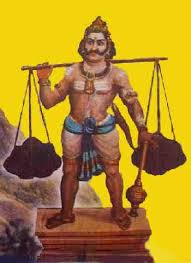 Thaipusam is a major festival dedicated to Lord Karthikeya. On this day, devotees of Lord Murugan offer fruits and flowers of his favorite colors either yellow or orange and wear clothes of the same color. Many devotees carry milk, water, fruits and floral tributes on their heads in pails. Some carry them kavadi hung from a wooden or bamboo pole and carry them on their shoulders to Murugan temples. It is called Thaipusam because the festival of Murugan is celebrated on the star of Pusam in the month of Thai (January – February).
Thaipusam is a major festival dedicated to Lord Karthikeya. On this day, devotees of Lord Murugan offer fruits and flowers of his favorite colors either yellow or orange and wear clothes of the same color. Many devotees carry milk, water, fruits and floral tributes on their heads in pails. Some carry them kavadi hung from a wooden or bamboo pole and carry them on their shoulders to Murugan temples. It is called Thaipusam because the festival of Murugan is celebrated on the star of Pusam in the month of Thai (January – February).
The way of devotees showing their extreme devotion is by kavadi. A kavadi is decorated with flowers, peacock feathers, and paper; and It is carried by devotees on their shoulders, with various foods tied to the both ends of the arch to balance the kavadi. The kavadi bearers follow strict disciplinary behavior by abstaining from all meat and sex during the ten days preceding the festival. They also undergo a special ceremony to put them in a trance-like state. They even subject their bodies to various degrees of physical torture, which may include tongue, cheeks, and upper bodies symmetrically pierced with vels (lances). Some of them even pierce their bodies with hooks and vels to pull the chariot carting Lord Murugan amidst incessant drumming, dancing and chanting.
Carrying Kavadi is symbolic of the burden Idumban underwent. As per the story, when Shiva in the form of Dakshina Murty was ready to impart knowledge, all the sages went to North to listen, resulting in imbalance between north and south. The Shiva sked Agastya to move to South with all his disciples to create balance. As Agastya was missing the two Vindhya mountains ‘Shiva Giri’ and ‘Shakti Giri’ in the south, he asked Idumban to bring those two mountains to South. He was carrying the two mountains in a kavadi with each mountain placed in a basket on each side of the kavadi. Since the journey was long and tedious, and since the mountains were heavy, he put them on the ground in Palani to rest. Murugan wanted to test the faith of Idumban to his Guru. Muruga made it impossible for Idumban to lift the mountains. In the fierce battle that ensued, Idumban was killed but was later restored to life. Idumban prayed Murugan to bless all the devotees who would carry the kavadi on their shoulders and should be given the privilege of standing guard at the entrance to the hill. For centuries, devotees to Palani bring their offerings on their shoulders in a kavadi to represent the burden of carrying two hills and receive Murugan’s blessings. Over the years, the custom has spread from Palani to all Muruga shrines worldwide, not just only in India.
He has many titles as a warrior. He is called Maha Sena; Senapati; Siddhasena, 'leader of the Siddhas'; and Yudharanga; Kumara, ‘the boy’; Guha, 'the mysterious one'; Saktidhara 'spear-holder'; and in South India, he is called Subrahmanya, Ganga-putra, 'son of the; Sarabhu, 'born in the thicket'; Tarakajit, 'vanquisher of Taraka;' and Dvadashakara 'twelve-handed.’
Lord Hanuman
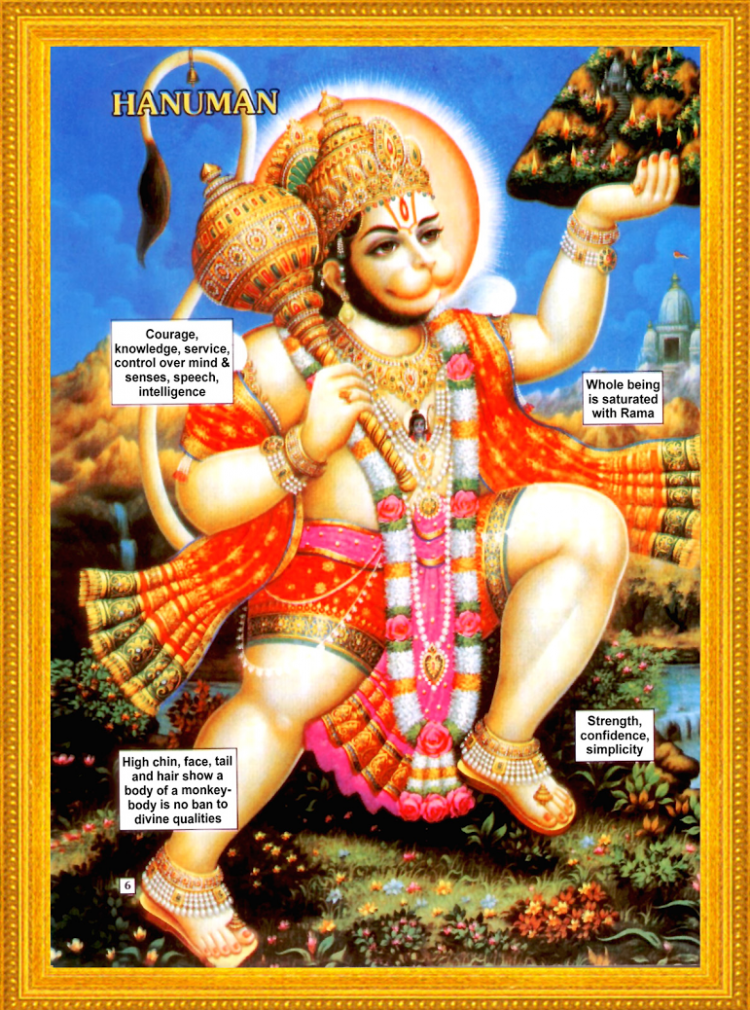 Hanuman is the central figure in the epic Ramayana and played crucial role in finding Sita in Lanka, burning the Island of Lanka, enraging Ravana, building the Ramasethu, saving the lives of Rama and Lakshmana, and advising Rama in the war. As a child, Hanuman saw the sun in the sky and thought that it was a fruit. Being a Vanara, he wanted to get it by leaping toward the sun to put it in his mouth and eat it. Gods were astonished to see young monkey leaping toward sun and thought if he consumed the sun there would be dark and devoid of light and life itself. At that moment, Indra threw his thunderbolt that struck Hanuman’s chin making him fall from the sky. His father Vayu was upset and withdrew his air from all living beings. Realizing that the very existence is at stake without air, all Gods approached Vayu to release the air. In gratitude, all Gods restored Hanuman back to life and blessed him with many powers.
Hanuman is the central figure in the epic Ramayana and played crucial role in finding Sita in Lanka, burning the Island of Lanka, enraging Ravana, building the Ramasethu, saving the lives of Rama and Lakshmana, and advising Rama in the war. As a child, Hanuman saw the sun in the sky and thought that it was a fruit. Being a Vanara, he wanted to get it by leaping toward the sun to put it in his mouth and eat it. Gods were astonished to see young monkey leaping toward sun and thought if he consumed the sun there would be dark and devoid of light and life itself. At that moment, Indra threw his thunderbolt that struck Hanuman’s chin making him fall from the sky. His father Vayu was upset and withdrew his air from all living beings. Realizing that the very existence is at stake without air, all Gods approached Vayu to release the air. In gratitude, all Gods restored Hanuman back to life and blessed him with many powers.
His form is "as vast as a mountain and as tall as a gigantic tower. His complexion is yellow and glowing like molten gold. His face is as red as the brightest ruby; while his enormous tail spreads out to an interminable length. He stands on a lofty rock and roars like thunder. He leaps into the air, and flies among the clouds with a rushing noise, whilst the ocean waves are roaring and splashing below "
Lord Brahma bestowed hanuman with a boon by which nobody could ever kill him with any type of weapon. He gave him the strength of creating fear and panic in his rivals and blessed him to destroy fear and panic among his followers. Indra gave the boon that his body would be stronger than Vajra. Varuna blessed him to remain protected from the influence of water while Agni protected him from the influence of fire. Surya bestowed Hanuman with two siddhis – garima and laghima whereby he can assume the huge and smallest form at will respectively. Kubera blessed him to remain happy and contented always. Yama blessed him with immortality while Vishwakarma blessed him to be protected from dangers of any kind of weapons and objects.
He was very mischievous and naughty. He often disturbed the sages by snatching away their personal puja items needed for performing religious rituals. during his childhood. Because of the boos received from various God, he went beyond his limits and started harassing the sages. Matangi Maharishi became angry and furious, and cursed Hanuman as thus: "O monkey, illusioned by our curse, you will for a long time be unaware of your own strength, by dint of which you harassed us. Your strength will again grow when you are reminded of your glory."
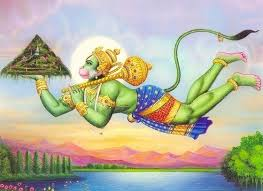 Hanuman Jayanthi is the major festival performed on the full moon day of Chaitra masa (month) across India to celebrate his birthday with minor variations. He is remembered as a true Karma Yogi who served tirelessly with dedication. His desire to serve Rama is matchless and his selfless service is accepted as a role model for everybody to follow. Numerous are his adventures that include crossing the ocean simply by uttering Ram-Nam, finding Sita Devi, burning the city of Lanka, and bringing the Sanjeevani herb and restoring Lakshmana to life again. He even saved the lives of Lord Rama and Laxman from Mahiravan by assuming five faces to extinguish five lamps at one time.
Hanuman Jayanthi is the major festival performed on the full moon day of Chaitra masa (month) across India to celebrate his birthday with minor variations. He is remembered as a true Karma Yogi who served tirelessly with dedication. His desire to serve Rama is matchless and his selfless service is accepted as a role model for everybody to follow. Numerous are his adventures that include crossing the ocean simply by uttering Ram-Nam, finding Sita Devi, burning the city of Lanka, and bringing the Sanjeevani herb and restoring Lakshmana to life again. He even saved the lives of Lord Rama and Laxman from Mahiravan by assuming five faces to extinguish five lamps at one time.
As per another legend, once Lord Hanuman saw Goddess Sita applying sindoor on her forehead. On seeing this, Lord Hanuman enquired the reason for Sita applying Sindoor. Goddess Sita replied that this would ensure a long life for her husband. Hanuman then smeared his entire body with sindoor to ensure Rama's immortality. On his birthday celebrations, devotees visit temples and apply sindoor to their foreheads from the Hanumans body as this is considered to be good luck.
He is known for his pure devotion and selfless surrender to Lord Rama. He exemplifies strength, courage, perseverance, fearlessness and unselfish service. He is highly educated and Surya was his Guru. Swami Sivananda says: He had Bhakti, Sakti, Vidya and Seva-Bhava, Brahmacharya and Nishkamya-Bhava. He never boasted of His bravery and intelligence. He said to Ravana, "I am a humble messenger of Sri Rama. I have come here to serve Rama, to do His work. By the command of Lord Rama, I have come here. I am fearless, by the grace of Lord Rama. I am not afraid of death. I welcome it, if it comes while I am serving Lord Rama." Mark here how humble Hanuman was! How devoted He was to Lord Rama! He never said, "I am brave Hanuman. I can do anything and everything."
Durga Devi
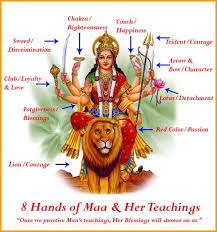 The birth of Durga Devi is very interesting and was purposefully created to kill buffalo demon Mahisasura. As per the legend the demon became so powerful that he defeated all the gods and drove them from their heavenly abode. They sought the help of Brahma, Vishnu and Maheswar to protect and save them. As they listened to their anguish, the Trinity emitted divine light formed like a huge mountain of boundless effulgence. In no time, it converted into a powerful, beautiful and dazzling woman, a Goddess of unimaginable strength.
The birth of Durga Devi is very interesting and was purposefully created to kill buffalo demon Mahisasura. As per the legend the demon became so powerful that he defeated all the gods and drove them from their heavenly abode. They sought the help of Brahma, Vishnu and Maheswar to protect and save them. As they listened to their anguish, the Trinity emitted divine light formed like a huge mountain of boundless effulgence. In no time, it converted into a powerful, beautiful and dazzling woman, a Goddess of unimaginable strength.
From the splendor of Lord Siva, her face was formed and from that of Yama, her tresses were gracefully shaped. From Vishnu's magnificence, her long, beautiful and extremely powerful hands were formed. From the splendor of the Moon Her breasts/chest was formed, from Indra's the Her waist was formed from Indra’s brilliance. From Varuna's energy, her thighs and shanks were formed. Her hips were formed from the strength of the Earth. From the splendor of Brahma, the Creator, her feet were formed. Her toes were formed from Sun God, Her fingers from Vasus, and her nose from Kubera. From the splendors of the Prajapatis were formed Her teeth, from Agni's the three eyes, from the dusk's and dawn's the beautiful eye brows and from the Vayu's the ears. From the splendors of other Devas, remaining parts of Her body were formed. Thus, all the Devas could see the divine form of the Goddess from the amalgamation of their splendors. All the Devas were extremely happy to looking at this glorious form and felt assured that she will bas able to kill the demon Mahisasura who was tormenting them.
To kill Mahisasura, different Gods gave different weapons gave variety of weapons to be use in the battle. Chakra was given by Lord Narayana; conch was bestowed by Varuna; bow and arrow were blessed by Surya; Trident was conferred by Shiva; thunderbolt was given by Indra; spear was blessed by Agni; quiver was bestowed by Vayu; sword and shield was bestowed by Yama; Kamandalu was conferred by Brahma; blinding rays were given by Surya; Lion was donated by Mount Himalaya, and so on.
Imbued with all the weapons and powers by all Gods, with her terrifying image, she roared like a lion agitating the Asuras. Mahisasura and all the demons grabbed their weapons rushed toward Devi. They were terrified to beheld her divine form. The twang of her bow reverberated the whole earth. He hands with respective weapons filled the space. She created hordes of Ganas to fight with the demons ensued. Blood started to flow like rivers. The demonic army of Mahisasura were killed in thousand. Mahisasura assumed various forms such as wild buffalo, lions, man with sword and shield, an elephant and then back to buffalo as she was killing one by one. Thus, she annihilated Mahisha.
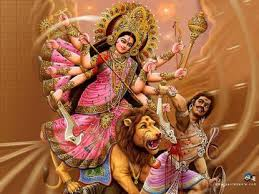 As per another legend, all Gods were being harassed by Shumbha and Nishumbha who were blessed by Lord Brahma that they cannot be killed in the hands of men. All Gods prayed to Durga Devi who was taking bath in Ganga. With their prayers, another goddess was formed to be known as Kalika. Shumbha sent Dhumralochana to fight with Mother. Just by saying “hum” she burnt to him to death. Then Shumbha sent Raktabija who had a boon that every drop of blood falls on the ground would become a demon. Realizing the potential multiplication of demons from the blood of Raktabjia, she ordered Chamunda to swallow the blood until he lost all his blood and died.
As per another legend, all Gods were being harassed by Shumbha and Nishumbha who were blessed by Lord Brahma that they cannot be killed in the hands of men. All Gods prayed to Durga Devi who was taking bath in Ganga. With their prayers, another goddess was formed to be known as Kalika. Shumbha sent Dhumralochana to fight with Mother. Just by saying “hum” she burnt to him to death. Then Shumbha sent Raktabija who had a boon that every drop of blood falls on the ground would become a demon. Realizing the potential multiplication of demons from the blood of Raktabjia, she ordered Chamunda to swallow the blood until he lost all his blood and died.
Then the fight began with Shumbha and Nishumbha. Lord Brahma, Lord Shiva, Karthikeya, Vaishnavi and Aindiri descended to help Kalika and killed Nishumbha. Finally, fierce fight broke out between Shumbha and Kalika with the death of demon. Kalika was going all around with intoxication of energy. Nobody could stop her from being obsessed with her killing mood. Gods send Lord Shiva to stop her from being so destructive. Shiva agreed and was lying on the battlefield when she realizes that she was stepping on her husband. Realizing the mistake, she felt ashamed and put her tongue out. That is how we see Kalika Devi picture with tongue out as she stepped on Lord Shiva.
She is known as Gauri, ‘brilliant’; Dasabhuja, ‘ten armed’; Simhavahini, ‘Riding on a Lion’; Mahishasuramardhini, ‘destroyer of Mahisasura’; Jagadhatri, ‘On who fosters the world’; Kali, ‘black’; Mukteshi, ‘one with disheveled hair’; Chinnamastaka, ‘decapitated’; Jagadgauri, ‘fairest in the world’; Jaganmata, mother of the world’; Kanyakumari, ‘the youthful virgin’; Simharathi, riding on a lion’; Sati, ’virtuous’; Girija, ‘mountain born’; Sarvamangala, ‘always aauspicious’, Chandika, 'the fierce'; and Bhairavi, 'the terrible'.
To access the first article of this topic, please click on the link:
https://www.savetemples.org/2017/02/02/mythology-and-symbology-of-hindu-gods-and-goddesses-lord-ganesh/
NOTE: Next article will address the symbolism of Lord Shiva.
DONATIONS
Please DONATE. Your donations are appreciated to continue the work.
NOTE: GHHF is exempt from federal income tax under section 501 (c) 3 of the Internal Revenue code.
Our tax ID # 41-2258630
Donate at: https://www.savetemples.org (click ‘Donate’ button on right side).
Where to send your DONATIONS?
Global Hindu Heritage Foundation
14726 Harmony Lane, Frisco, TX 75035.
Your donations are tax deductible. Our Tax ID: # 41-2258630
Any questions, call: Prakasarao Velagapudi
Please subscribe to Save Temples Telegram channel at https://t.me/savetemples



















